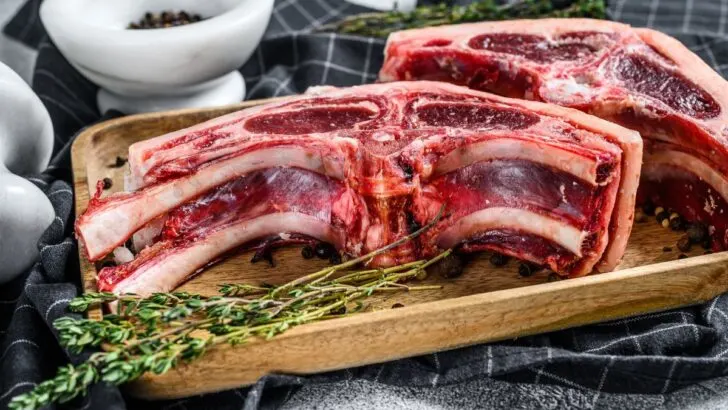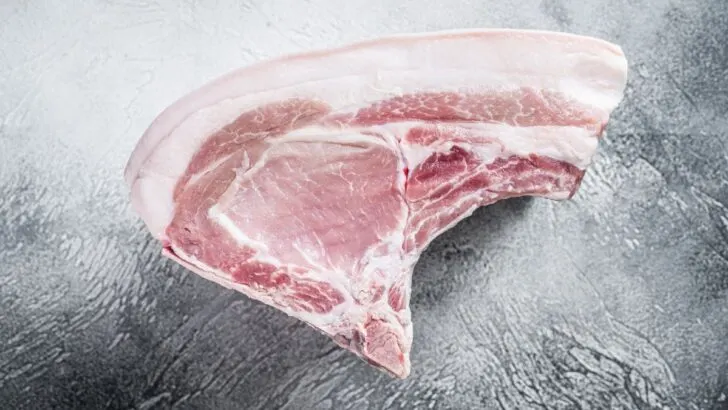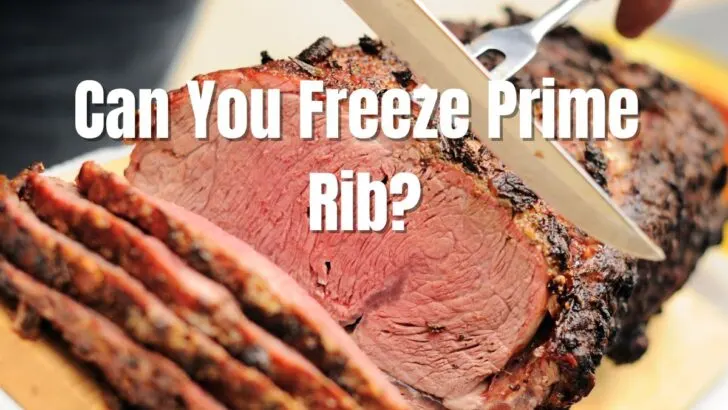We all know how good prime ribs are, fresh, juicy, rich, and tender.
For a good reason, it takes center stage during the holiday season.
There is no better option for cooking with meat other than prime rib. But cooking it and keeping it for another day is a different story.
If you also want to save it for another occasion, you must be wondering how to keep the leftovers or if you can freeze prime rib.
You can freeze prime rib, but for the best flavor, it all varies based on how you intend to prepare it later. If you defrost it and then cook it, your ribs will get dry and tough. But if you slow cook it from it being frozen, it will yield much better results.
Whichever method you choose, ensure you are not leaving your prime rib at room temperature for 2 hours or more.
You are relieved that you can freeze your prime rib, but here’s more to the story. Before hopping to your freezers, you must know how to freeze your uncooked or cooked prime rib.
Let us walk you through it.

Best Way to Freeze Raw Prime Rib?
If your prime rib is uncooked or raw, keep everything together. This will make sure that the beef’s flavor is prevalent once you serve your juicy ribs.
A typical roast weighs between 6 to 12 pounds and contains a maximum of five ribs, while a complete roast weighs up to sixteen pounds. This implies that freezing flesh is not even a question.
Therefore, as a first step, you should make sure that there is sufficient space in the freezer. Doing this will allow more airflow around your prime rib, which will make it freeze quickly.
However, the leading causes of frozen meat spoilage are moisture, oxygen, bacteria, and light, which can build when the other three factors are present.
Therefore, it’s always better to freeze instantly and double up on your protective measures.
- Vacuum Seal
As previously stated, it is ideal to make sure that every ounce of oxygen is removed from your rib’s packaging to maximise the freezer lifespan of this pricey meat.
The most promising method for achieving this is to vacuum pack your meat. This will remove the moisture and oxidation problems. It also protects against freezer burn!
Also, to avoid any inconvenience, you should label the packaging with a date. This can maintain the meat fresh for approximately a year.
This period is determined by the meat’s exposure to light and the temperature remaining consistently below 0° Fahrenheit.
Indeed, with enough light, you will notice significant changes in the flavour and colour of the meat. To get rid of this, use heavy-duty aluminium foil to create another protective coating around your vacuum seal.
Cover your prime rib in foil, ensure not a single ray of light passes there, and then allow it to freeze.
- Frozen Wrap
Freezer wrap is an excellent substitute if you are out of a vacuum sealer. Cover the meat tightly in aluminium foil, then wrap it again.
You can also put the prime rib in a sealed bag. But make an effort to evacuate as much air as possible.
Finally, do the same as marking the date. Using this method, you can freeze the prime rib for up to 12 months. Also, avoid using aluminium foil on your rib’s meat directly.
The aluminium will easily break off during defrosting, abiding by your prime rib. Therefore, always use a sealed bag or freezer wrap first.
- Original Wrapping
The third alternative is to place your rib in its plastic wrapping and cover it with layers of aluminium foil.
Then, like the frozen wrap approach, put it in a sealed bag. Next, extract the air as well as label it before placing it in the freezer.
Freezing Cooked Prime Rib
You can apply the same freezing techniques for your cooked rib too. However, there is an important step you should take before freezing it.
Let it cool completely. Place the meat on a baking tray or platter after removing it from the cooking tray. Place it in the refrigerator or on the countertop to let it cool.
If cooling at room temperature, keep it under two hours; or else, your meat can spoil.
Then, as before, follow the packing instructions. Vacuum sealing and frozen wrap are both acceptable methods.
However, as this is not a raw product, it will only keep in your freezers for almost six months. As a result, label your wrapping and store it as soon as possible.
How to Use Prime Rib After Freezing
When you’ve appropriately frozen the prime rib and are prepared to use it, you must also be prepared for the cooking process.
How you use your frozen prime rib may differ depending on your plans. We recommend that you defrost your prime rib in the refrigerator overnight before attempting to reheat it.
Simply heat the prime rib and start serving it as the entree meat once more.
If you serve it this way, heat it in the oven. Cover your pot with boiling water and bake at 350°F until warmed through. This should take no more than 20 minutes.
If you intend to use your prime rib to make soup, a casserole, or another type of dish, simply cook it with other parts of the meal.
However, you could avoid defrosting your prime rib entirely for these processes.
It will be simpler to work with if you defrost your prime rib. Of course, if you’re like the rest of us, you probably forget to take things out of the freezer and plan. It can happen to anyone.
In such a case, you can defrost it using a microwave or an instant defrost with cold water. These methods can come in handy when you’re in a jam and work excellently.
If you notice that your meat is becoming dry, sprinkle it or baste it with water.
We are confident that you will be pleased with the results of the prime rib upon freezing it. Your family and taste buds will both thank you later.

Does Freezing Prime Rib Have Any Adverse Effects?
Prime rib, like any other type of meat, is a biodegradable food that cannot be stored for long periods.
If you’ve never had the chance to learn proper storage methods, this information may surprise you.
If you’ve never had the chance to learn proper storage methods, this information may surprise you. When meat freezes, the texture changes, and some muscle fibers leak.
This leads to a less tender bite as well as an increase in fat in your diet, which isn’t always good for us.
If you plan to freeze prime rib, keep in mind that you will need to cook it longer than usual because it has been frozen.
So you might not want to eat it right away after preparing it. Before serving, the USDA recommends cooking prime rib to a temperature of 145 degrees.
The internal temperature of a well-done roast should be approximately 180 degrees Fahrenheit.
If you won’t be eating your prime rib for up to 9 months, freezing it is an excellent temporary solution.
If you tend to freeze it more than this, the texture of the meat will be less than desirable.
If you still have to freeze your prime rib for longer, use a freezer bag or an airtight container with no additional air inside.
This will help to keep the moisture in and the delicious flavour.
Final Words On Freezing Prime Rib
To summarise, prime rib is a delicate, delicate cut of meat that everyone should try.
Cooking this treat will result in a memorable meal that your friends and family will discuss for years.
If you have any leftover prime rib, it’s a good idea to keep it in the freezer for later. Follow the methods discussed in this article to get the best outcome for your prime ribs.


